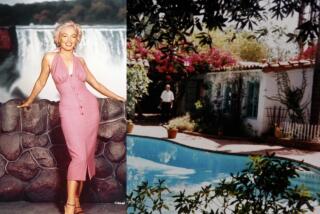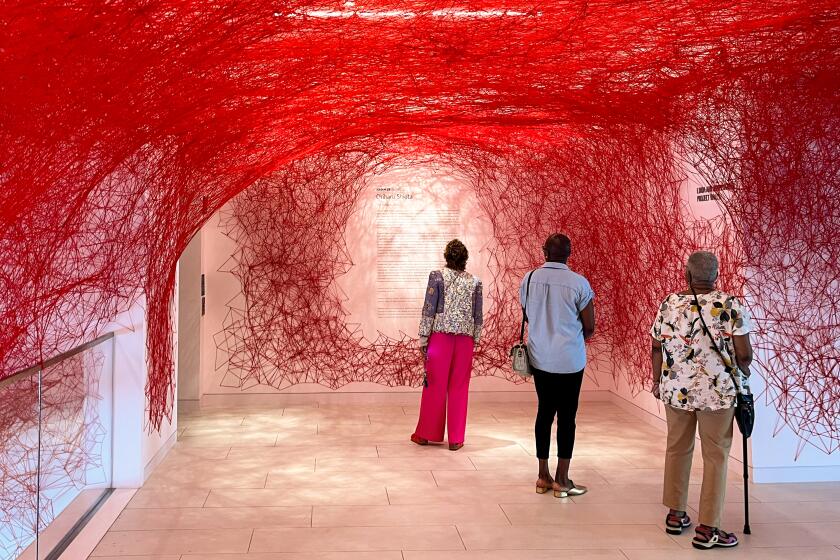Karma-Carrying Member of the Laguna Scene : Art: For decades, Andy Wing has engulfed himself in the community and its essence. His home is a showcase for his work and his personal ‘guidance system.’
Andy Wing, whose life has been one long embrace of chance events, still marvels at his fortuitous discovery of Laguna Beach 44 years ago.
*
“My experience of Laguna touched on every aspect of my life that would become meaningful to me,” the gangling, bearded 63-year-old artist said recently as he showed a visitor around his sunlit home and studio in Thurston Park, where meandering dirt paths lead to fanciful homes and lushly rebellious gardens.
Growing up comfortably in Greenwich, Conn., and Manhattan, Wing was no stranger to culture. His grandmother painted delicate landscapes, his father edited Farm and Fireside magazine, and his mother, who worked in advertising, played tennis at the country club. A teacher at his private school had taught him how to do Jackson Pollock-style drip paintings years before most people had heard of the Abstract Expressionist artist.
But Laguna Beach--where his older sister, Nan, ran a frame shop with her husband, painter Leonard Kaplan--was another world entirely. The summer after high school, Wing rented a room in town from a follower of Vedanta, a Hindu pantheistic philosophy.
“She blew my mind with Oriental religion,” Wing said. “I never dreamed those kinds of mystical things ever existed. . . . It stuck with me all through college. Everyone else was studying ‘The Odyssey’ and ‘The Iliad,’ which I had already read, and I was doing research into the Hindu epics.”
That magic summer, he parlayed previous experience working for Bucks County Playhouse in Pennsylvania into a job building sets for the Pageant of the Masters. There were roasts at the beach and informal house parties, jazz haunts and poetry readings. A blind psychologist got him interested in psychotherapy. It was hip and relaxed and mind-expanding, and Wing was in heaven.
Back East, Wing majored in art at Bard College in upstate New York. After graduation, he put in a brief stint at an ad agency in Manhattan and made art in a rented room on a horse ranch in Santa Fe, N.M. But Laguna Beach had given him “an ambience,” and he had to return.
So in 1957, he turned a $50-a-month rental on Cleo Street into a home and studio. The next year it became an art gallery too. Kaplan, David Rosen, his wife, Jane Callender, Tom Blackwell, political cartoonist Frank Interlandi and other artists showed work there and held life-drawing classes.
A few years later, Wing settled on Victory Walk in Thurston Park, where he still lives.
*
“There’s a kind of karma when people live here 30, 40 years,” he said. “I checked my inner-outer voice guide system, and it said, ‘Don’t leave.’
Down the street, Nan Wing and Peter Carr, then head of the Cal State Long Beach department of English, presided over meetings of Laguna Poets.
“I used to sit and do drawings while they read erotic poems,” Wing reminisced. “When spring was in the air.”
Something more pungent began wafting through the air in the late ‘60s, when a couple thousand hippies descended on the city of about 13,000 residents. Thurston Park’s most famous resident of that time was Timothy Leary, the LSD apostle, who was busted there in his parked station wagon in 1968.
To appease the business community, Mayor-elect Richard Goldberg pledged to condemn the ramshackle houses where hippie drug dealers lived.
“The No. 1 target was this neighborhood,” Wing said. “I got very upset.”
Concerned about violations of civil rights and widespread condemnation of homes that didn’t conform to the building code, he wrote a protest petition signed by several hundred people. He and a pal unrolled the taped-together petitions “from one end of City Hall to the other,” Wing said. “Little did I know I was doing performance art.”
Goldberg’s plan was shelved, but Thurston Park was designated as a “housing deficiency area,” which proved unexpectedly beneficial. The area received a new sewer and water system, and the city approved a plan that legalized the charming irregularities of home sites originally laid out for weekend campers.
Redevelopment allowed Wing to build what he calls “the studio home of my dreams.” A tiled path leads to the high-ceilinged, light-flooded dwelling. Inside, the walls are covered with Wing’s flowing abstract paintings and organically structured mixed-media pieces, some of which were begun in one decade and completed in another.
Walking his visitor through a lifetime of “phases, digressions and experiments,” Wing proudly showed off the various ways he incorporates junk and discards. He stretches canvases over objects (such as a mandala-like bicycle wheel) and extends the impact of his desert-hued fields of color with wide painted frames he calls “environments,” built from lath strips from a now-defunct used lumber yard.
Among the oldest works on view is a group of “automatic drawings” (rapid sketches made without conscious awareness of what one is putting on paper). These mutant floating figures were the fruits of long mind-warping nights of throwing the I Ching--the ancient Chinese system of using symbolic hexagrams to predict the future--with his “mentor-guru” Mirkla Marks.
But most of his output has been non-figurative, alluding to aspects of nature, chance and the native population of the Americas. The pottery shards that find their way into numerous Wing works are souvenirs of a 1956 trip to an abandoned pueblo near Santa Fe. Although he didn’t realize at the time that he was toting away pieces of a cultural heritage, he said ruefully, he uses the shards in ways that honor the “empowerment” existing within them.
“I have my own guidance system,” Wing said, his brown eyes peering closely at his visitor. “The thing is that nothing is fixed, and everything can speak to you. . . . When you become attuned in that way, it’s very interesting.”
*
During the 1993 Laguna Beach fire, residents were asked to evacuate the area. But he saw several red cars--which he interprets as a sign of imminent danger--on Laguna Canyon Road. So he turned around, pitched in and ultimately saved an elderly neighbor and two houses.
A work Wing made two decades ago also owes its existence to a special moment of synchronicity. While marching in an anti-war demonstration protesting an armaments conference, he found a small remnant of a car wreck: a fire-blasted hunk of steel bearing the inscription “America.” Set within a mosaic of Native American pottery shards mounted on a steering wheel, the twisted object looks like a souvenir from Armageddon.
“It’s the first time I ever did a piece where I became disoriented,” Wing said. “I just sat there and deep-breathed for 10 minutes. It was the closest thing to death, of anything I’ve ever done.”
It has even occurred to him that when a leaf drops onto a painting--a common occurrence, given the outdoors is his favorite studio space--it must mean, “Leaf it alone.” Well, it’s one way to know when to stop.
For all his mystical fervor, Wing does have a wry sense of humor. After showing his second I Ching series in the Festival of Arts in 1984, he asked the I Ching what he had accomplished.
“No noble pat on the back from the beyond [was forthcoming],” he wrote later. “The answer was simply, ‘Exhaustion.’ ”
More to Read
Start your day right
Sign up for Essential California for news, features and recommendations from the L.A. Times and beyond in your inbox six days a week.
You may occasionally receive promotional content from the Los Angeles Times.






